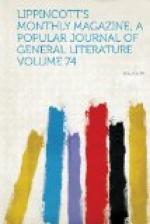After this introduction by our sweet and quaint romancer, the reader will hardly need be told that the two strangers stood in the presence of America’s now illustrious artist, George L. Brown. But one seeing him then, as he stood almost scowling at the two strangers, would hardly have idealized him into the artist whose pencil has done so much of late years to give American art a distinctive name through his poetical delineations of the rare, sun-tinted atmosphere that hovers over Italian landscapes. However, our apology for him must be that the day was raw and blustering, and that he had no sooner caught sight of the men through his window, as they hesitatingly entered the door, than his suspicions were aroused.
The Italian acted as spokesman, and inquired if there were any rooms to let in the building. Brown, thinking this the easiest way of ridding himself of the visitors, went in search of the landlord, who came, and after a moment’s conversation the whole party entered the studio, much to its owner’s displeasure.
The cicerone did most of the talking, though now and then the other made a remark or two in broken Italian. But this was only for the first few moments. He soon became oblivious of all save art, of which one could see at a glance he was passionately fond. One of Mr. Brown’s pictures—a large one he was then engaged on—particularly attracted his attention. He drew closer and closer to the canvas, examining it with a minuteness that showed the connoisseur, and finally remarked: “It is very fine in color, sir, and the atmosphere is delicious. Why have I not heard of you before?” examining the corner of the canvas for the artist’s name, but speaking in a tone and with an air that gave Brown the impression he was indulging in the random flattery so current in studios. So, ignoring the question, he asked with a slight shrug of the shoulders, “Are you an artist?”
“I paint a little,” was the reply, with an air of modesty which Brown mistook for the bashful half-assertion of some daubing amateur.
Just then the cicerone came forward and announced that the bargain was completed and the room ready for occupancy.
“I shall be happy—no, happy is not a good word for me—I shall be glad to see you in my studio when I have moved in, and perhaps you may see some things to please you.”
So saying, the stranger departed, leaving Brown not a whit better impressed with him than at first.




